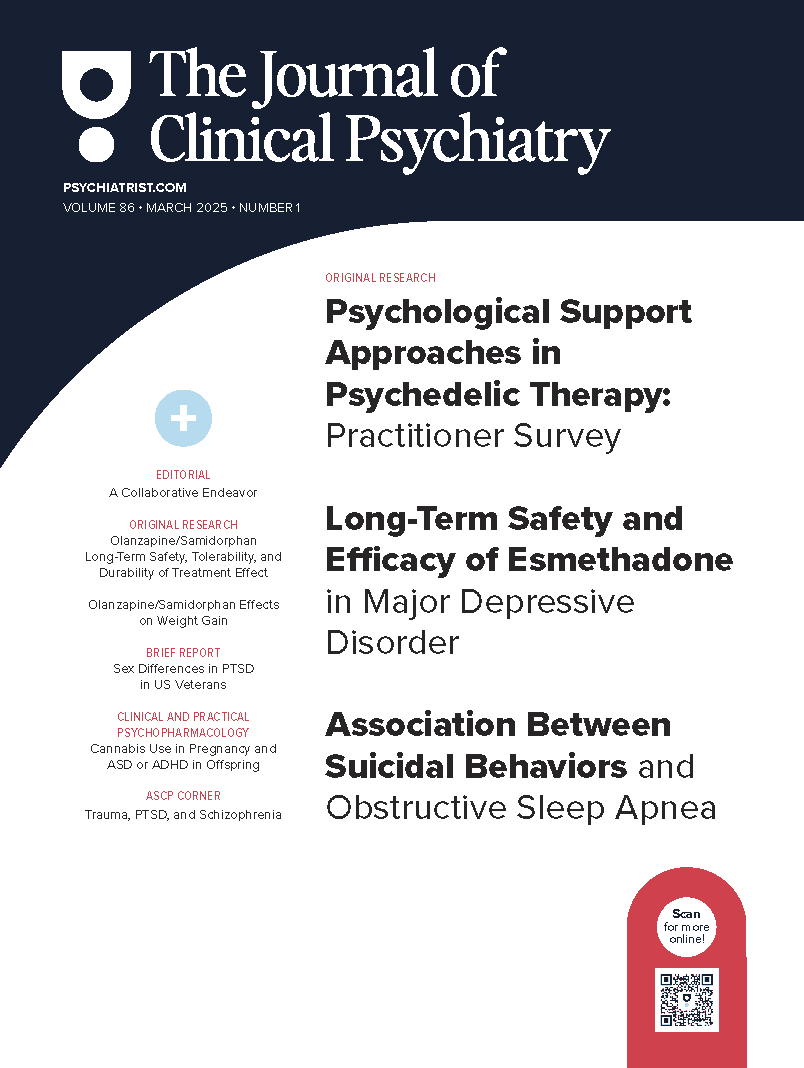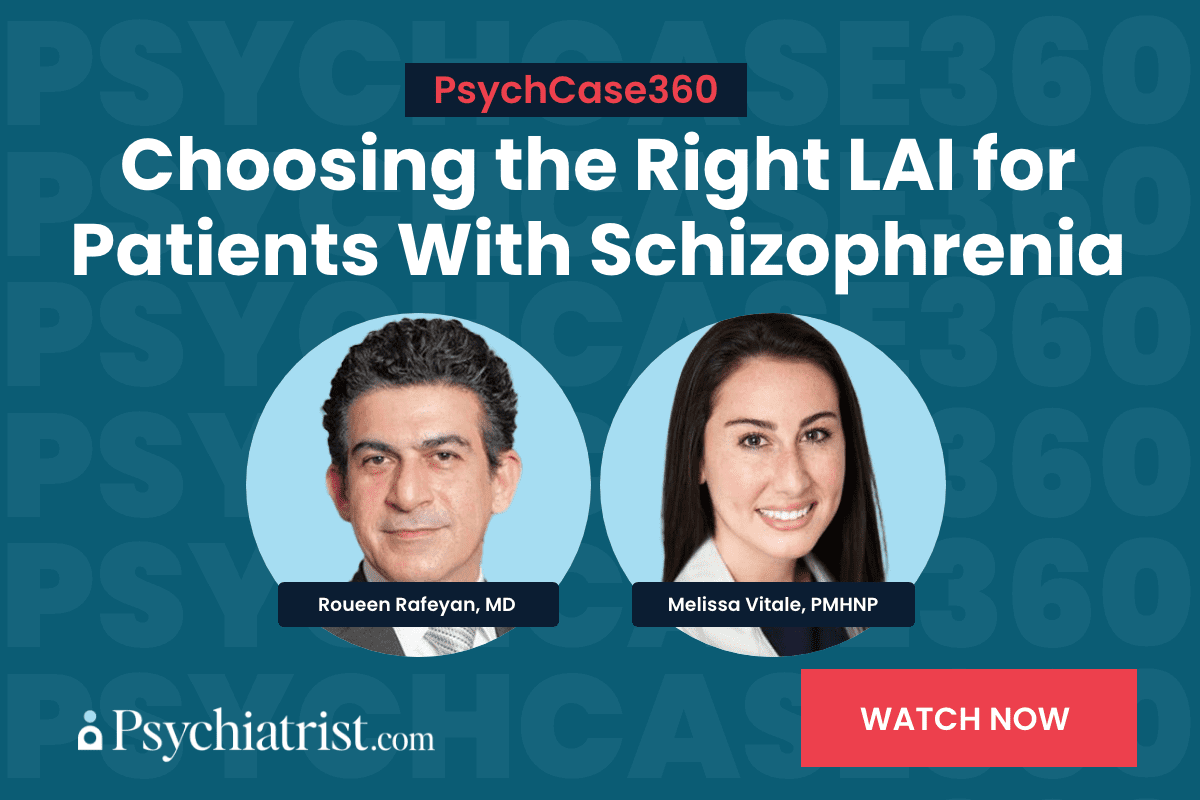ABSTRACT
Objective: Research on reactive attachment disorder (RAD) has focused on institutionalized samples, and long-term outcomes have not been described. This study examines the natural history of RAD into adulthood in a US community sample.
Methods: The electronic medical record of a tertiary care center was reviewed for individuals who received an ICD-9 or ICD-10 diagnosis of RAD between 3–12 years old and were ≥ 18 years old at the start of the study; data were collected between February and June 2018. Children with RAD (n = 49) were identified and psychiatric, social, and medical outcomes were collected in childhood and adulthood. A subset of the RAD cohort with comorbid attention-deficit/hyperactivity disorder (ADHD) based on ICD codes (n = 34) was compared with age-matched controls with ADHD and without attachment disorders (n = 102).
Results: Children with RAD had high rates of adult psychiatric diagnoses (73.5%), substance use (42.9%), suicide attempts (28.6%), and psychiatric hospitalizations (71.4%). They also demonstrated poor psychosocial outcomes, including low high school (34.7%) and college (2.0%) graduation, high unemployment (26.5%), state-funded health insurance (65.3%), and legal issues (34.7%). Compared to children with ADHD alone, children with RAD and ADHD had higher rates of comorbid adult psychiatric diagnoses (OR 3.0, P = .02), suicide attempts (OR 7.5, P < .01), and hospitalizations (OR 6.4, P < .01).
Conclusions: This study describes the natural history of RAD into adulthood in a non-institutionalized sample. The findings suggest that children with RAD have a high burden of psychiatric comorbidities and reduced psychosocial functioning into adulthood that extend beyond the impairment associated with ADHD, a common comorbidity in RAD. These findings highlight the continuous impact of early attachment difficulties on the developmental trajectory of children.
J Clin Psychiatry 2023;84(6):23m14994
Author affiliations are listed at the end of this article.
Members Only Content
This full article is available exclusively to Professional tier members. Subscribe now to unlock the HTML version and gain unlimited access to our entire library plus all PDFs. If you’re already a subscriber, please log in below to continue reading.
References (52)

- American Psychiatric Association. DSM-III. Diagnostic and Statistical Manual of Mental Disorders. Third Edition. American Psychiatric Association; 1980.
- Zeanah C, Gleason MM. Reactive Attachment Disorder: A Review for DSM-V. American Psychiatric Association; 2010.
- American Psychiatric Association. Diagnostic and Statistical Manual of Mental Disorders: DSM-5. Fifth Edition. American Psychiatric Association; 2013.
- O’Connor TG, Rutter M; English and Romanian Adoptees Study Team. Attachment disorder behavior following early severe deprivation: extension and longitudinal follow-up. J Am Acad Child Adolesc Psychiatry. 2000;39(6):703–712. PubMed CrossRef
- Smyke AT, Dumitrescu A, Zeanah CH. Attachment disturbances in young children, I: the continuum of caretaking casualty. J Am Acad Child Adolesc Psychiatry. 2002;41(8):972–982. PubMed CrossRef
- Zeanah CH, Smyke AT, Dumitrescu A. Attachment disturbances in young children, II: indiscriminate behavior and institutional care. J Am Acad Child Adolesc Psychiatry. 2002;41(8):983–989. PubMed CrossRef
- Marshall PJ, Fox NA. Bucharest Early Intervention Project Core Group. A comparison of the electroencephalogram between institutionalized and community children in Romania. J Cogn Neurosci. 2004;16(8):1327–1338. PubMed CrossRef
- Nelson CA, Parker SW, Guthrie D; Bucharest Early Intervention Project Core Group. The discrimination of facial expressions by typically developing infants and toddlers and those experiencing early institutional care. Infant Behav Dev. 2006;29(2):210–219. PubMed CrossRef
- Nelson CA 3rd, Zeanah CH, Fox NA, et al. Cognitive recovery in socially deprived young children: the Bucharest Early Intervention Project. Science. 2007;318(5858):1937–1940. PubMed CrossRef
- Rutter M, Colvert E, Kreppner J, et al. Early adolescent outcomes for institutionally-deprived and non-deprived adoptees, I: disinhibited attachment. J Child Psychol Psychiatry. 2007;48(1):17–30. PubMed CrossRef
- Rutter M, Kreppner J, Croft C, et al. Early adolescent outcomes of institutionally deprived and non-deprived adoptees, III: quasi-autism. J Child Psychol Psychiatry. 2007;48(12):1200–1207. PubMed CrossRef
- Marshall PJ, Reeb BC, Fox NA, et al. Effects of early intervention on EEG power and coherence in previously institutionalized children in Romania. Dev Psychopathol. 2008;20(3):861–880. PubMed CrossRef
- Bos KJ, Fox N, Zeanah CH, et al. Effects of early psychosocial deprivation on the development of memory and executive function. Front Behav Neurosci. 2009;3:16. PubMed CrossRef
- Ghera MM, Marshall PJ, Fox NA, et al. The effects of foster care intervention on socially deprived institutionalized children’s attention and positive affect: results from the BEIP study. J Child Psychol Psychiatry. 2009;50(3):246–253. PubMed CrossRef
- Zeanah CH, Egger HL, Smyke AT, et al. Institutional rearing and psychiatric disorders in Romanian preschool children. Am J Psychiatry. 2009;166(7):777–785. PubMed CrossRef
- McLaughlin KA, Fox NA, Zeanah CH, et al. Delayed maturation in brain electrical activity partially explains the association between early environmental deprivation and symptoms of attention-deficit/hyperactivity disorder. Biol Psychiatry. 2010;68(4):329–336. PubMed CrossRef
- Smyke AT, Zeanah CH, Fox NA, et al. Placement in foster care enhances quality of attachment among young institutionalized children. Child Dev. 2010;81(1):212–223. PubMed CrossRef
- Bos K, Zeanah CH, Fox NA, et al. Psychiatric outcomes in young children with a history of institutionalization. Harv Rev Psychiatry. 2011;19(1):15–24. PubMed CrossRef
- Fox NA, Almas AN, Degnan KA, et al. The effects of severe psychosocial deprivation and foster care intervention on cognitive development at 8 years of age: findings from the Bucharest Early Intervention Project. J Child Psychol Psychiatry. 2011;52(9):919–928. PubMed CrossRef
- Almas AN, Degnan KA, Radulescu A, et al. Effects of early intervention and the moderating effects of brain activity on institutionalized children’s social skills at age 8. Proc Natl Acad Sci U S A. 2012;109(suppl 2):17228–17231. PubMed CrossRef
- Smyke AT, Zeanah CH, Gleason MM, et al. A randomized controlled trial comparing foster care and institutional care for children with signs of reactive attachment disorder. Am J Psychiatry. 2012;169(5):508–514. PubMed CrossRef
- Windsor J, Moraru A, Nelson CA, et al. Effect of foster care on language learning at eight years: findings from the Bucharest Early Intervention Project. J Child Lang. 2013;40(3):605–627. PubMed CrossRef
- Gleason MM, Fox NA, Drury SS, et al. Indiscriminate behaviors in previously institutionalized young children. Pediatrics. 2014;133(3):e657–e665. PubMed CrossRef
- Almas AN, Degnan KA, Walker OL, et al. The effects of early institutionalization and foster care intervention on children’s social behaviors at age 8. Soc Dev. 2015;24(2):225–239. PubMed CrossRef
- Bick J, Zhu T, Stamoulis C, et al. Effect of early institutionalization and foster care on long-term white matter development: a randomized clinical trial. JAMA Pediatr. 2015;169(3):211–219. PubMed CrossRef
- Humphreys KL, Gleason MM, Drury SS, et al. Effects of institutional rearing and foster care on psychopathology at age 12 years in Romania: follow-up of an open, randomised controlled trial. Lancet Psychiatry. 2015;2(7):625–634. PubMed CrossRef
- Almas AN, Degnan KA, Nelson CA, et al. IQ at age 12 following a history of institutional care: Findings from the Bucharest Early Intervention Project. Dev Psychol. 2016;52(11):1858–1866. PubMed CrossRef
- Vanderwert RE, Zeanah CH, Fox NA, et al. Normalization of EEG activity among previously institutionalized children placed into foster care: a 12-year follow-up of the Bucharest Early Intervention Project. Dev Cogn Neurosci. 2016;17:68–75. PubMed CrossRef
- Humphreys KL, Nelson CA, Fox NA, et al. Signs of reactive attachment disorder and disinhibited social engagement disorder at age 12 years: effects of institutional care history and high-quality foster care. Dev Psychopathol. 2017;29(2):675–684. PubMed CrossRef
- Bick J, Zeanah CH, Fox NA, et al. Memory and executive functioning in 12-year-old children with a history of institutional rearing. Child Dev. 2018;89(2):495–508. PubMed CrossRef
- Zeanah CH, Chesher T, Boris NW; American Academy of Child and Adolescent Psychiatry (AACAP) Committee on Quality Issues (CQI). Practice parameter for the assessment and treatment of children and adolescents with reactive attachment disorder and disinhibited social engagement disorder. J Am Acad Child Adolesc Psychiatry. 2016;55(11):990–1003. PubMed CrossRef
- US Department of Health and Human Services, Administration on Children, Youth and Families, Children’s Bureau. The AFCARS Report No. 27. June 23, 2020. https://www.acf.hhs.gov/cb/report/afcars-report-27
- Minnis H, Macmillan S, Pritchett R, et al. Prevalence of reactive attachment disorder in a deprived population. Br J Psychiatry. 2013;202(5):342–346. PubMed CrossRef
- Lehmann S, Havik OE, Havik T, et al. Mental disorders in foster children: a study of prevalence, comorbidity and risk factors. Child Adolesc Psychiatry Ment Health. 2013;7(1):39. PubMed CrossRef
- McMillen JC, Zima BT, Scott LD Jr, et al. Prevalence of psychiatric disorders among older youths in the foster care system. J Am Acad Child Adolesc Psychiatry. 2005;44(1):88–95. PubMed CrossRef
- Kraemer GW. A psychobiological theory of attachment. Behav Brain Sci. 1992;15(3):493–511. PubMed CrossRef
- Hong M, Moon DS, Chang H, et al. Incidence and comorbidity of reactive attachment disorder: based on national health insurance claims data, 2010–2012 in Korea. Psychiatry Investig. 2018;15(2):118–123. PubMed CrossRef
- Pritchett R, Pritchett J, Marshall E, et al. Reactive attachment disorder in the general population: a hidden ESSENCE disorder. ScientificWorldJournal. 2013;2013:818157. PubMed CrossRef
- Holst Y, Thorell LB. Functional impairments among adults with ADHD: a comparison with adults with other psychiatric disorders and links to executive deficits. Appl Neuropsychol Adult. 2020;27(3):243–255. PubMed
- Biederman J, Faraone SV, Spencer TJ, et al. Functional impairments in adults with self-reports of diagnosed ADHD: a controlled study of 1001 adults in the community. J Clin Psychiatry. 2006;67(4):524–540. PubMed CrossRef
- Biederman J, Faraone SV, Spencer T, et al. Patterns of psychiatric comorbidity, cognition, and psychosocial functioning in adults with attention deficit hyperactivity disorder. Am J Psychiatry. 1993;150(12):1792–1798. PubMed CrossRef
- Biederman J, Petty C, Fried R, et al. Impact of psychometrically defined deficits of executive functioning in adults with attention deficit hyperactivity disorder. Am J Psychiatry. 2006;163(10):1730–1738. PubMed CrossRef
- Biederman J, Petty CR, Woodworth KY, et al. Adult outcome of attention-deficit/hyperactivity disorder: a controlled 16-year follow-up study. J Clin Psychiatry. 2012;73(7):941–950. PubMed CrossRef
- Eakin L, Minde K, Hechtman L, et al. The marital and family functioning of adults with ADHD and their spouses. J Atten Disord. 2004;8(1):1–10. PubMed CrossRef
- Wilens TE, Dodson W. A clinical perspective of attention-deficit/hyperactivity disorder into adulthood. J Clin Psychiatry. 2004;65(10):1301–1313. PubMed CrossRef
- St Sauver JL, Grossardt BR, Leibson CL, et al. Generalizability of epidemiological findings and public health decisions: an illustration from the Rochester Epidemiology Project. Mayo Clin Proc. 2012;87(2):151–160. PubMed CrossRef
- Rocca WA, Yawn BP, St Sauver JL, et al. History of the Rochester Epidemiology Project: half a century of medical records linkage in a US population. Mayo Clin Proc. 2012;87(12):1202–1213. PubMed CrossRef
- Rothman KJ. No adjustments are needed for multiple comparisons. Epidemiology. 1990;1(1):43–46. PubMed CrossRef
- Feise RJ. Do multiple outcome measures require p-value adjustment? BMC Med Res Methodol. 2002;2(1):8. PubMed CrossRef
- Sheftall AH, Asti L, Horowitz LM, et al. Suicide in elementary school-aged children and early adolescents. Pediatrics. 2016;138(4):e20160436. PubMed CrossRef
- Mayes SD, Calhoun SL, Waschbusch DA, et al. Reactive attachment/disinhibited social engagement disorders: callous-unemotional traits and comorbid disorders. Res Dev Disabil. 2017;63:28–37. PubMed CrossRef
- Radel MB, Crouse G, Ghertner R, et al. Substance Use, the Opioid Epidemic, and the Child Welfare System: Key Findings from a Mixed Methods Study. US Department of Health and Human Services. March 7, 2018. https://aspe.hhs.gov/sites/default/files/private/pdf/258836/SubstanceUseChildWelfareOverview.pdf





